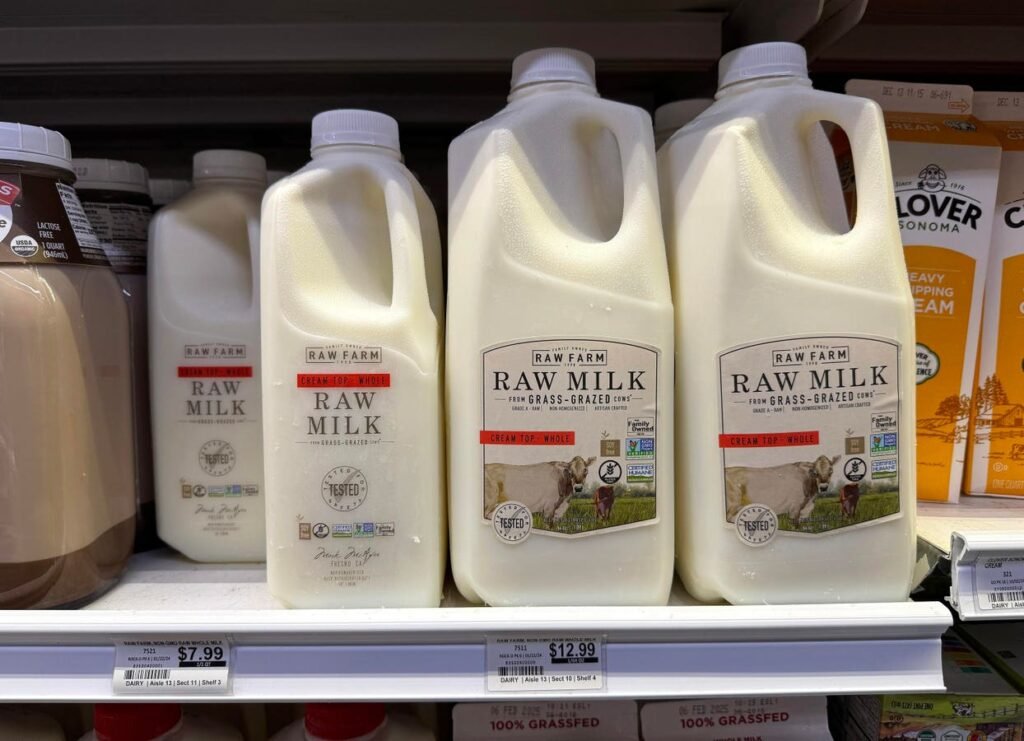BERKELEY, CALIFORNIA – NOVEMBER 25: Containers of Raw Farm raw milk are displayed on a shelf at … [+]
U.S. officials have increased the testing of raw milk as a bird flu (H5N1) outbreak spreads among the nation’s cattle.
The Department of Agriculture will conduct tests on raw milk samples nationwide following a federal order issued on Friday. Dairy farms will be required to provide samples upon request.
This initiative aims to assist public health officials in monitoring the disease’s spread, which has affected cattle significantly since its initial detection in U.S. cows in March. Additionally, it aims to safeguard agricultural workers who may come into contact with the disease through livestock under their care.
While FDA testing has detected harmless, inactive traces of the virus in pasteurized milk since April, raw milk that has not undergone this process can harbor live bird flu.
As of now, none of the 58 human cases reported in the U.S. have been linked to raw milk. Most cases have been tied to exposure to poultry and cattle.
However, last month, two batches of raw whole milk and cream products contaminated with the bird flu virus were recalled in California, the state most impacted by the cattle outbreak.
While bird flu has mainly resulted in mild symptoms in individuals, some cases in other countries have led to severe illness. Currently, the virus cannot spread from person to person.
What Is Raw Milk?
Raw milk is simply milk that has not been pasteurized, a process that partially sterilizes the product by deactivating most bacteria and viruses.
Although most milk in the U.S. undergoes pasteurization before being sold, some is sold in its raw form.
Advocates claim that raw milk tastes better and offers more nutritional benefits compared to pasteurized milk. However, scientific evidence supporting these claims is limited. John Lucey, director of the University of Wisconsin’s Center for Dairy Research and a food science professor, stated that claims of health benefits from raw milk lack substantial research evidence, as reported by USA Today.
“You are being misled by these claims,” he emphasized. “This is fraudulent.”
On the other hand, the risks associated with consuming raw milk are well-documented.
Untreated milk and dairy products can harbor dangerous pathogens. Bacteria such as salmonella, E coli, and listeria monocytogenes can thrive in unpasteurized milk, along with viruses causing diseases like tuberculosis, diphtheria, and scarlet fever.
Between 2013 and 2019, raw milk was responsible for 75 foodborne illness outbreaks in the U.S., affecting 675 individuals, half of whom were newborns to age 19.
What Is Pasteurization?
Pasteurized milk undergoes a heating process to eliminate or deactivate harmful microorganisms. Other beverages like juice, wine, and beer are also commonly pasteurized for safety reasons.
Various pasteurization techniques exist, but the high-temperature, short-time method used by the U.S. dairy industry effectively prevents bird flu virus contamination. This involves heating milk to a minimum of 161 degrees Fahrenheit (71 degrees Celsius) for 15 seconds.
The process of pasteurization was named after microbiologist Louis Pasteur, who developed a method for partially sterilizing wine in 1864.
Before World War II, milk was responsible for approximately 25% of foodborne illnesses in the U.S. Pasteurization, which drastically reduced this risk, is widely regarded as one of the most successful food safety interventions in history.
Can Raw Milk Transmit Bird Flu?
The implications of consuming raw milk contaminated with bird flu remain uncertain. Nevertheless, experts caution that the potential risks associated with drinking raw milk outweigh any perceived benefits. Unpasteurized milk has previously caused severe illnesses such as bovine tuberculosis and typhoid fever.
The FDA strongly advises against consuming raw milk due to the risk of bird flu contamination. It is prohibited in certain states and cannot be sold across state lines.
Experts like Kerry E. Kaylegian, associate research professor of food science at Penn State, support the FDA’s stance.
“Given that medical researchers are still studying how H5N1 is transmitted, I agree with the FDA’s position that raw milk poses risks that are not worth taking,” she wrote in an article for The Conversation.
Please rewrite this sentence.


